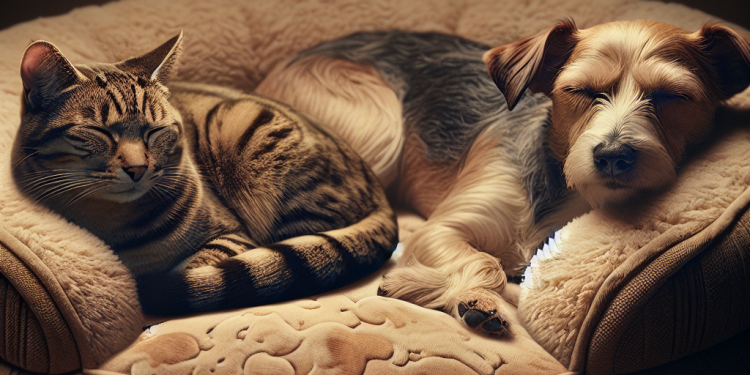Laying the Foundation for a Blended Pet Family
Picture this: a cat snoozing on the windowsill, a dog curled at your feet—a snapshot of domestic bliss. Sounds dreamy, right? But anyone who’s tried blending a family of whiskers and wagging tails knows it’s not always a walk in the park. The good news? Cats and dogs can be best buds, or at least learn to live in serene indifference. The key? A solid foundation. To achieve this harmony, it’s essential to understand the distinct personalities and communication styles of each pet. Just like people, pets are individuals with their own likes, dislikes, and social languages. By catering to these individual needs while also fostering a shared sense of belonging, you’ll be setting the stage for a peaceful coexistence.
First and foremost, ditch the notion that Fido and Whiskers can’t coexist. They can! Training both is non-negotiable; it’s like giving them a secret handshake. It’s about control and communication—without it, you’ve got chaos. And no, you can’t just toss them together and hope for the best. You’ve got to be the cool-headed matchmaker they need. Introduce structure with consistent training sessions, harnessing positive reinforcement to encourage desirable behavior. Remember, it’s not just about issuing commands; it’s about cultivating a shared language that enables inter-species understanding and respect.
Set the stage for success. Create a chill-out zone for your pets—no surprise pounces or sneak attacks. Keep things low key and avoid the drama. Think of it as setting up a dating profile for your pets; you wouldn’t want to scare off potential matches with an overly-enthusiastic greeting, right? Patience is your new best friend. This dedicated space should be neutral territory, free from the pre-established domain of either pet. This approach reduces the intrinsic need to defend their space and resources, thereby minimizing potential conflicts right from the start.
Navigating the First Encounters with Tailored Acclimatization Methods
Now, let’s tackle those first hellos. Imagine a first date behind a barrier—it sounds weird, but hear us out. Pet gates, crates, and separate rooms aren’t just for time-outs; they’re your wingmen in the sniff-and-greet game. It’s like online chatting before meeting in person. This way, when your pets finally set eyes on each other, it’s not a blind date from hell. Gradual introductions allow each pet to become comfortable at their own pace, reducing anxiety and promoting curiosity over fear. It’s about creating a controlled environment that allows for gradual exposure and positive experiences.
And let’s talk scents. Swapping their bedding or rubbing a towel on one to share with the other is like exchanging favorite hoodies—it’s personal, it’s intimate, it’s a scent-imental journey. It’s about building a scent profile that says, “Hey, I know you!” before they’ve even met. And always keep an eye out—unsupervised first dates are a big no-no. By sharing scents in this way, you’re laying a pheromone pathway to friendship. This olfactory introduction can significantly reduce the initial shock and discomfort of a face-to-face meeting, paving the way for a calmer, more accepting relationship.
Building Trust with Scent Markers and Safe Boundaries
Trust is like a garden; it needs time and the right conditions to grow. And in the pet world, scent is king. So, let those scent markers do the heavy lifting. It’s not just about sniffing butts; it’s about creating a roadmap of familiar, comforting smells. And boundaries? They’re like the garden fence, keeping things safe and secure. By respecting these boundaries and allowing for the natural dissemination of each pet’s unique scent within the shared environment, you’re encouraging a sense of mutual trust to develop organically. It’s a subtle yet powerful process that lays the groundwork for peaceful interactions.
Cats need their high-rise condos (a.k.a., perches) to survey their kingdom, and dogs need their cozy corners. It’s all about honoring their need for space and privacy. Plus, having their own turf reduces the chances of turf wars. It’s about respecting their need to retreat and recharge—after all, even pets need a little me-time. Affording each pet these personal sanctuaries acknowledges their instinctual needs, reducing stress and competition over territory, which is often the root of inter-pet tension.
Honoring Individual Territorial Needs for Lasting Peace
Lastly, let’s cement this truce for the long haul. Cats and dogs have different ideas about personal space. Cats are the solo adventurers, and dogs are the pack animals. It’s like living with an introvert and an extrovert. Give them their own zones—they’ll be more Zen than a yoga retreat. By recognizing and accommodating these divergent needs for space and socialization, you’re not only helping to circumvent potential disputes but are also providing an environment in which both cats and dogs can thrive.
Understanding their behaviors, their quirks, and their silent (or not so silent) communication is crucial. Tail wags and purrs can be misread across the species aisle. And remember, this isn’t a sprint; it’s a marathon. The introduction dance can take weeks, even months, but it’s worth every careful step. Take it slow, reinforce good vibes with treats and praise, and stay alert to their cues. Tailoring your approach to each pet’s comfort level ensures a gradual acclimation process that prioritizes their well-being and nurtures a harmonious dynamic.
In the end, creating a multi-pet household where everyone gets along is about more than just avoiding fur-fueled fiascos. It’s about fostering a home filled with understanding, respect, and maybe even a little love between paws and claws. With these strategies in your back pocket, you’ll be well on your way to a peaceable kingdom—or at least a détente at the food bowl. Keep it cool, keep it consistent, and let the harmony unfold. The ultimate goal is to write a story of cohabitation that’s less about a ceasefire and more about crafting a symphony of coexistence where each pet’s needs are met harmoniously.






